Metformin vs. acarbose, which lowers blood sugar faster? What is the basis for this?
Metformin and acarbose, both commonly used hypoglycemic drugs for type 2 diabetics, many friends do not know the difference between these 2 drugs, and the difference in their hypoglycemic effect. In fact, because it is from a different mechanism of action to lower sugar, therefore, the comparability between these 2 drugs is not large, there is no which drug lowering sugar effect better, today to introduce you to these 2 common hypoglycemic drugs it.
Metformin we have said a lot, as the application of more than 60 years of a classic old drug, metformin is still the first choice of type 2 diabetes mellitus and the basic drug, the general recommendation is that if there is no contraindication to the use of metformin, metformin can be retained in type 2 diabetes mellitus patients throughout the drug regimen. Metformin's hypoglycemic drug action has 3 main aspects, one is to reduce hepatic glycogen synthesis and inhibit hepatic glycogen conversion, the second is to enhance insulin sensitivity and improve muscle absorption and utilization of glucose, and the third is also able to reduce the intestinal cell absorption of glucose, while increasing the level of glucagon-like peptide (GLP-1).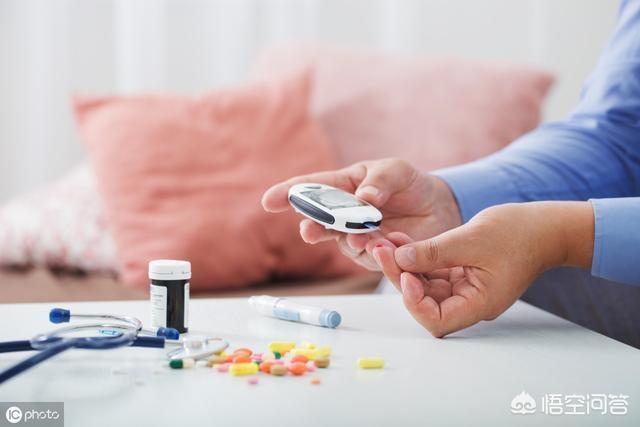
Therefore, in terms of mechanism of action, metformin has a comprehensive control of blood glucose levels, not only for postprandial blood glucose, but also for fasting blood glucose. Large samples of clinical research data show that long-term use of adequate metformin (daily dose of 2000 mg) can make the average fasting blood glucose decreased by 3.2 mmol / L, the average postprandial blood glucose decreased by 4.0 mmol / L, while the glycated hemoglobin level can be reduced by about 1.8%, such a level of glucose lowering, so that the metformin has become a leading oral hypoglycemic drugs, therefore, we generally recommend that for the use of metformin for the control of glucose level is all-round, not only can control the postprandial blood glucose, but also can play a certain role in controlling the fasting blood glucose. We generally recommend that, for those who are physically tolerant to taking metformin, during the initial treatment of type 2 diabetes, metformin should first be applied in full dosage (the daily dose reaches 2,000mg, i.e., 2.0g), and then other types of hypoglycemic drugs should be added to strengthen glycemic control if the glycemic control still fails to reach the target, based on strengthening the control of life and the application of metformin in full dosage.
A little more about acarbose.
Acarbose belongs to the α-glucosidase inhibitor class of hypoglycemic drugs, and its main action is different from metformin. Acarbose, a hypoglycemic drug, mainly slows down the intestinal absorption of carbohydrates, so as to achieve the effect of lowering and controlling the postprandial blood sugar. It is mainly targeted at diabetic patients whose blood glucose is not easy to control after meals that usually consist of carbohydrates as the main food. When controlling blood glucose after meals, taking acarbose helps to control blood glucose level after meals better.
Acarbose is a safe oral hypoglycemic drug, but taking Acarbose to control blood glucose, to meet 2 conditions, one is the rise in blood glucose to postprandial blood glucose rise, and the second is the dietary habits, carbohydrate-based diet. Only in line with these 2 regulation, taking acarbose, will have the desired effect of sugar control.
To summarize, these 2 drugs are applied in different directions, if it is the initial control of new-onset diabetes, long-term control of diabetic blood glucose, first of all, metformin is still recommended, if you want to control the postprandial blood glucose level, to play a better postprandial blood glucose control effect, acarbose is one of the better choices.
In addition, in the combined application of hypoglycemic drugs, the combination of metformin and acarbose is also a good combination. Metformin is able to control both fasting and postprandial glucose, and acarbose helps in postprandial glucose control, and the combination of these 2 medications is a very good combination of oral medications for enhancing glycemic control in diabetic patients. It should be noted that by themselves, these 2 drugs alone do not cause the risk of hypoglycemia, but if these 2 drugs are taken together, the risk of hypoglycemia may occur. When hypoglycemia occurs, correcting hypoglycemia should not be done with sucrose or starchy foods, these are often ineffective, and the hypoglycemia can be corrected by taking glucose or honey by mouth.
Hello everyone! I'm Dr. Yang, a general practitioner who focuses on blood pressure, glucose, lipid, and uric acid management. Let me answer the question.
First of all the proposition of the question is somewhat flawed. The question says, "Which lowers blood sugar faster?" Does "faster" mean a few hours, a day, two days, or a month? Although we require blood glucose to reach the standard as soon as possible, if the blood glucose value from the very high blood glucose value suddenly drops significantly in a short period of time (usually 1 hour glucose drop of 5.1 mmol / L or more), it is possible to induce hypoglycemia symptoms.
But if you're hard pressed to compare which of the two hypoglycemic drugs lowers sugar fasterIt's actually hard to compare。We don't have to deliberately pursue which drug is faster in lowering glucose, but should be concerned about which drug is more effective in lowering glucoseThe effect of lowering glucose is closely related to the dosage of the drug. In turn, the effect of lowering sugar is closely related to the drug dose. Our guidelines for the prevention and treatment of type 2 diabetes mention that theThe glucose-lowering efficacy of 300 mg of acarbose per day was comparable to that of 1,500 mg of metformin per day in patients with first-diagnosed diabetes.
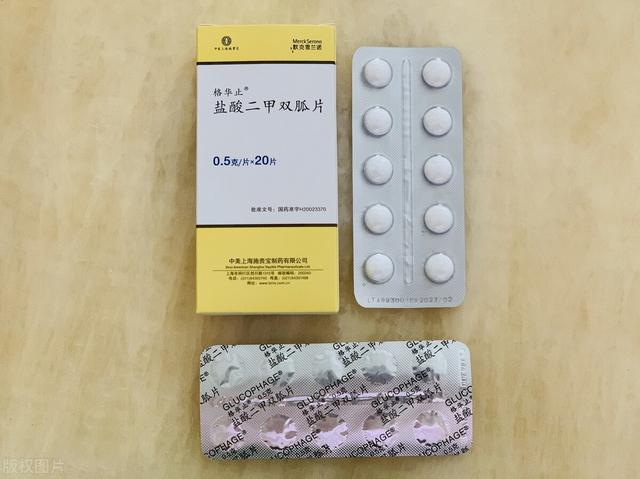
However, the two hypoglycemic drugs cannot always be switched, the pharmacological mechanisms of both drugs are different
Metformin exerts its glucose-lowering effect by reducing hepatic glucose output and improving peripheral insulin resistance, whereas acarbose lowers postprandial blood glucose by inhibiting the absorption of carbohydrates in the upper part of the small intestine. The two are actually in a complementary relationship.The mechanism of metformin's action is relatively complex, not only lowering blood glucose comprehensively, but also improving insulin resistance, thus obtaining an effect other than lowering blood glucose, reducing the occurrence of cardiovascular events and the risk of death. Therefore, as long as there is no contraindication, metformin is still the first choice of drugs for diabetic patients. Acarbose, on the other hand, is more suitable for people with high postprandial blood glucose, according to its mechanism of action. This is something that just makes up for Metformin's shortcomings. If you find that your fasting blood sugar is up to standard after taking a sufficient amount of metformin, but your postprandial blood sugar is not yet up to standard, you can add acarbose as long as there are no contraindications. Therefore, metformin and acarbose can be used in combination, but it is not recommended to switch them to prevent large fluctuations in blood sugar.
It is also important to note that the most common side effect of both drugs is that they causeGastrointestinal reactions, such as diarrhea and bloating. So to minimize the occurrence of such side effects, we usually start with a small dose and then gradually increase the dose. Of course, both also have the common advantage that they bothIt does not cause hypoglycemia.
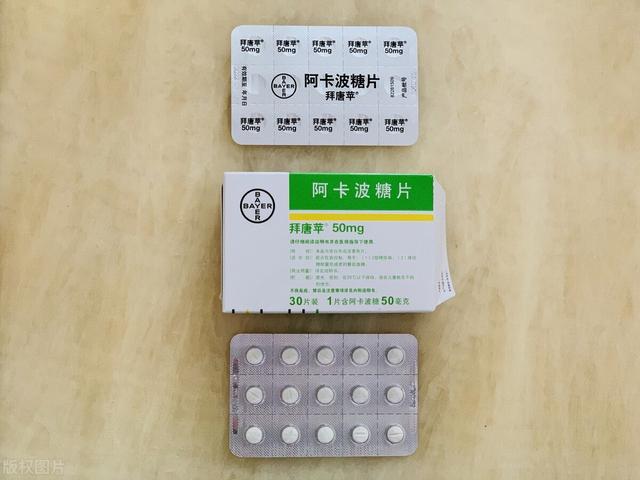
Well, today will say so much, if you think it is okay to speak on the point of praise it ~ there are questions you can pay attention to me to get more relevant health knowledge, thank you for reading!
Metformin is the most widely used oral hypoglycemic drug in clinical practice, which does not promote insulin secretion per se, but exerts hypoglycemic effect by reducing glycogen synthesis in the liver, inhibiting the conversion of hepatic glycogen into glucose, increasing the body's sensitivity to insulin, better absorbing and utilizing glucose, inhibiting glucose absorption by small intestinal cells, and increasing secretion of intestinal pro-insulin, which is the first-line and first choice of hypoglycemic drug for the treatment of type 2 diabetes mellitus as recommended by the guidelines for diabetes mellitus at home and abroad. It is the first-line and preferred hypoglycemic agent for the treatment of type 2 diabetes. In addition, Metformin can also reduce body weight by suppressing appetite, lowering blood insulin level and increasing leptin sensitivity, which is especially suitable for obese or overweight patients with type 2 diabetes mellitus, and can reduce triglyceride and total cholesterol, improve lipid profile, anticoagulation, anti-platelet aggregation, inhibit vascular fibrosis, and reduce the risk of vascular complications in diabetes mellitus.
Acarbose is also a commonly used first-line oral hypoglycemic agent in clinical practice, belonging to the α-glucosidase inhibitors, which inhibit the conversion of carbohydrates such as starch, disaccharide, dextrin and other carbohydrates in the food into glucose by inhibiting the activity of glucosidase, thus slowing down the absorption of carbohydrates in the small intestine and lowering the postprandial blood glucose, which can help to reduce fluctuation of blood glucose throughout the day and lower the average value of blood glucose by improving postprandial blood glucose. In addition, Acarbose also has the role of lowering blood pressure, regulating blood lipids, cardiovascular protection, etc., and persistent use can reduce the risk of coronary heart disease, myocardial infarction and other macrovascular pathologies.
Metformin can reduce fasting blood glucose, postprandial blood glucose and glycated hemoglobin in patients with type 2 diabetes mellitus, while acarbose can reduce postprandial blood glucose and glycated hemoglobin, and its effect on postprandial blood glucose is stronger, and in terms of the intensity of glucose-lowering, metformin is better, but the glucose-lowering mechanism of metformin is not to stimulate the secretion of insulin, but to act on the glucose metabolism process, and to protect damaged pancreatic islet β-cells by improving glucose metabolism. By improving glucose metabolism, it protects the damaged pancreatic β-cells and avoids further damage to the pancreatic β-cells, so its hypoglycemic effect is slower, and it is suitable for the long-term control of blood glucose, whereas acarbose, when taken orally, can rapidly combine with α-glucosidase in the small intestine, thereby delaying the conversion of carbohydrates in food into glucose and lowering the postprandial blood glucose, and its hypoglycemic effect depends on the food, so its hypoglycemic effect has a faster onset of effect.
Metformin is mainly used for long-term control of blood glucose, while acarbose is mainly used to control postprandial blood glucose, the two have different therapeutic directions, if the use of metformin blood glucose can reach the standard, there is no need to use acarbose, if the use of metformin postprandial blood glucose can not meet the standard, you can combine the use of acarbose, for patients with type 2 diabetes mellitus, metformin should be taken throughout the whole process, but if the postprandial glucose is stable, it can be discontinued Acarbose, therefore, alternating between metformin and acarbose will inevitably cause blood glucose fluctuations, thus increasing the risk of various diabetic complications, therefore, alternating is not recommended.
References:
Metformin Hydrochloride Tablets Instructions
Acarbose Tablets Instructions
Expert Consensus on the Clinical Use of Metformin (2016 Edition)
Metformin and acarbose are both commonly used as first-line drugs in the clinical setting for patients with type 2 diabetes mellitus, but they have different mechanisms of action and cannot be substituted for each other.
metformin
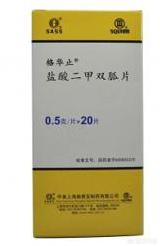 Metformin is one of the most widely used oral hypoglycemic agents worldwide, and because of its efficacy, safety, and cardiovascular benefits, the major diabetes guidelines at home and abroad recommend that both overweight and normal-weight type 2 diabetic patients should be treated with metformin from the beginning, unless there are contraindications or intolerable, and that the combination therapy regimen should include metformin, reflecting the importance of this drug in the treatment of diabetes. metformin, reflecting the importance of this drug in the treatment of diabetes.
Metformin is one of the most widely used oral hypoglycemic agents worldwide, and because of its efficacy, safety, and cardiovascular benefits, the major diabetes guidelines at home and abroad recommend that both overweight and normal-weight type 2 diabetic patients should be treated with metformin from the beginning, unless there are contraindications or intolerable, and that the combination therapy regimen should include metformin, reflecting the importance of this drug in the treatment of diabetes. metformin, reflecting the importance of this drug in the treatment of diabetes.
The glucose-lowering mechanism of metformin is 3-fold:
1 Acts on the liver to inhibit gluconeogenesis and reduce hepatic glucose output
2 Acts on peripheral tissues (muscle, fat) to improve muscle glycogen synthesis, reduce fatty acids, increase insulin sensitivity, and increase glucose uptake and utilization
3 Acts in the intestines to inhibit glucose uptake by intestinal wall cells, thereby reducing glucose absorption in the small intestine
The hypoglycemic effect of metformin was positively correlated with dose, with 500 mg per day lowering glycated hemoglobin by 0.6%.Reduced glycated hemoglobin by 2% at 2000mg.. Enteric-coated tablets are usually taken 30 minutes before a meal, regular tablets may be taken with or after a meal, and extended-release tablets are usually, taken at dinner or immediately after a meal.
Metformin lowers both fasting and postprandial blood glucose, but primarily lowers fasting blood glucose.
acarbose (loanword)
 Acarbose is an alpha glucosidase inhibitor, which reduces postprandial blood glucose primarily by inhibiting the absorption of carbohydrates in the upper part of the small intestine. Therefore, alpha glucosidase inhibitors are indicated for patients with carbohydrates as the main food component and elevated postprandial blood glucose. In other words, acarbose has no glucose-lowering effect on fasting blood glucose and is not effective for higher fat intake and lower sugar intake.Acarbose is only a 0.5% reduction in glycated hemoglobin, which is weaker relative to metformin. And acarbose needs to be chewed at the same time as the first bite to be effective.
Acarbose is an alpha glucosidase inhibitor, which reduces postprandial blood glucose primarily by inhibiting the absorption of carbohydrates in the upper part of the small intestine. Therefore, alpha glucosidase inhibitors are indicated for patients with carbohydrates as the main food component and elevated postprandial blood glucose. In other words, acarbose has no glucose-lowering effect on fasting blood glucose and is not effective for higher fat intake and lower sugar intake.Acarbose is only a 0.5% reduction in glycated hemoglobin, which is weaker relative to metformin. And acarbose needs to be chewed at the same time as the first bite to be effective.
reach a verdict
In summary, metformin is mainly to reduce fasting blood glucose, acarbose is mainly to reduce postprandial blood glucose, metformin action is stronger than acarbose, the two in the clinical application can not be interchangeable.
Metformin and Acarbose are the most widely used drugs to lower blood sugar by reducing the amount of glucose produced and the amount of glucose entering the bloodstream. However, many sugar users are confused as to which one is faster, has fewer side effects and how to choose between them. Today, "Ask the Doctor" will analyze the comparison for you.
Mechanism of action of the two drugs
(1) Metformin
Metformin reduces the rate and total amount of glucose absorbed from the intestines, inhibits the isomerization of substances such as proteins into glucose, and hinders glycogenolysis, thereby reducing hepatic glucose output and the total amount of glucose entering the bloodstream.
Metformin inhibits glycogenolysis, which also suppresses the appetite of sugar lovers, so it is especially suitable for obese type 2 diabetics. However, it is not recommended for those with heart failure, liver and kidney insufficiency, and those in stressful situations such as trauma. In addition, long-term use of metformin can cause a decrease in the level of vitamin B12, which should be supplemented in moderation.
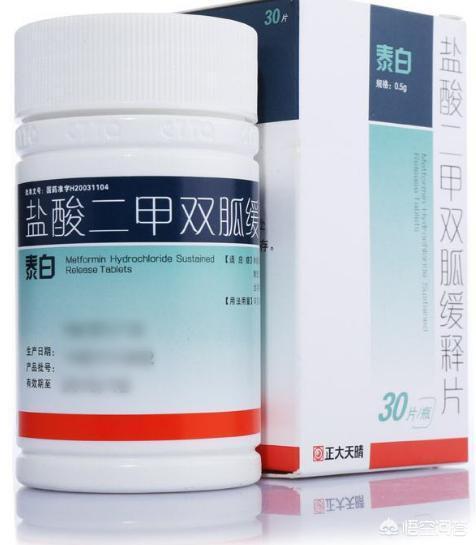
(2) Acarbose
It is an α-glucosidase inhibitor, which can inhibit the α-glucosidase in the small intestine, preventing the decomposition of polysaccharides and sucrose into glucose, and slowing down the absorption of glucose accordingly, thus alleviating postprandial hyperglycemia and achieving the effect of lowering blood glucose.
Since acarbose will hinder the decomposition and absorption of carbohydrates in the intestinal tract, prolong their retention time, lead to bacterial fermentation, and increase gas production, individual sugar users are prone to intestinal gas, abdominal pain, diarrhea and other adverse reactions.
"Ask the doctor" suggests that when you take it, swallow the rice with acarbose, so that it will be relieved. However, it is contraindicated for people with obvious digestive and absorption dysfunction, hernia, intestinal stenosis and ulcers.

Can I switch between acarbose and metformin?
Many sugar lovers think, "Metformin and Acarbose can be switched. If metformin is not effective in lowering sugar, switch to acarbose. If the effect is not good after acarbose, switch to metformin." Is that really true?
Generally speaking, sugar lovers who still have poor control of postprandial blood sugar after taking metformin can switch to acarbose. However, acarbose has a short onset of action and is less effective in controlling fasting blood glucose, and at this time, if metformin is completely discontinued, fasting blood glucose may rise.
Conversely, if a sugar patient taking acarbose is switched to metformin because of poor fasting glucose control, postprandial glucose may rise.That said, acarbose is more effective at lowering postprandial blood sugar and metformin is more effective at controlling fasting blood sugar.

Combination therapy: complementing strengths for better results
To summarize, the method of using acarbose alone or metformin alone does not control blood sugar 100%, based on this situation, we can use the combination of two drugs.
There are two main reasons for the use of metformin and acarbose combination therapy: first, as we mentioned before, whether metformin alone, or acarbose alone, can not be 100% balance between fasting and postprandial glucose; second, because if a large dose of a particular type of hypoglycemic agent, it is more likely to produce adverse drug reactions, and the drug will occur earlier "failure The second reason is that if you take a large dose of a particular hypoglycemic drug, you are more likely to have adverse drug reactions and the drug will "wear off" earlier.
Therefore, glucose lovers who are not effective with a single hypoglycemic agent can choose the combination of metformin and acarbose.
How exactly should I take it in combination?
Although metformin and acarbose are not insulin-promoting drugs by themselves and do not carry the risk of hypoglycemia. However, the combination of the two may increase the risk of hypoglycemia, so the exact way to take them should not be decided on your own, but in consultation with your primary care physician.
The above content is edited and organized by "ask the doctor" for you, want to know more practical knowledge, welcome you to pay attention to us.
Metformin and acarbose are commonly used drugs for diabetic patients, they can either lower blood sugar alone or in combination with other drugs to lower blood sugar, so can they be used differently? Who can lower blood sugar faster? Next, let's find out.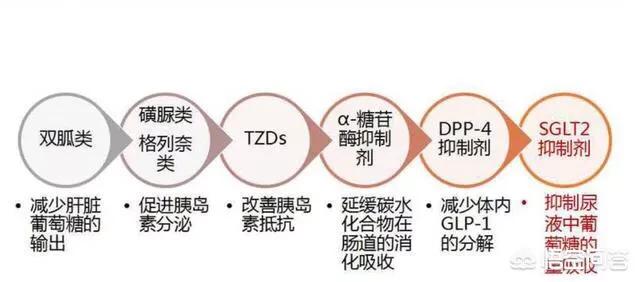
Metformin mainly reduces fasting blood glucose and postprandial blood glucose, which is suitable for all diabetic patients; Acarbose mainly reduces postprandial blood glucose, which is suitable for diabetic patients with predominantly elevated postprandial blood glucose. Both can be used alone for diabetic patients who have been ineffective in diet or exercise treatment, but if fasting and postprandial blood glucose elevation is the main concern, metformin should be chosen; for patients with postprandial blood glucose elevation, metformin and acarbose are both available. In the combined hypoglycemic regimen, metformin is the mandatory drug of choice for almost all treatment regimens. This is inseparable from the pharmacological effects of metformin: metformin not only reduces blood glucose, but also increases the sensitivity of peripheral tissues to insulin. Combined with insulin, it can reduce the dosage of insulin; combined with pro-insulin secretion agents, such as sulfonylurea oral hypoglycemic agents, it can produce 1+1>2 hypoglycemic effect.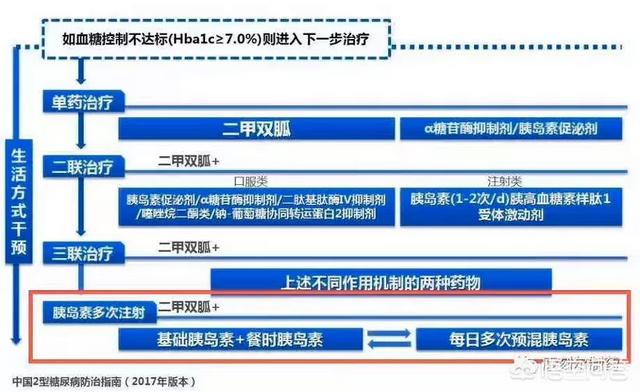
Now to answer the question posed by the questioner:
Can metformin and acarbose be switched? If it is used as a single agent to control postprandial hyperglycemia, it can be switched; if it is accompanied by elevated fasting blood glucose, do not switch; if it is a multidrug combination to lower blood glucose, metformin cannot be replaced by acarbose.
Who lowers blood sugar faster, metformin or acarbose? As for who is faster in lowering blood glucose, I personally think that there is no need to compare. The two lowering blood sugar mechanism is different, and can not be exchanged one for one, the goal of hypoglycemic treatment is long-term smooth control of blood glucose to reach the standard, from this point of view, there is an indicator with reference value: glycated hemoglobin. Glycated hemoglobin is a response to the overall control of blood glucose in the last three months, normally no more than 6%, the control goal of ordinary diabetic patients is no more than 7%. Metformin reduces glycated hemoglobin by about 1-2% and acarbose reduces glycated hemoglobin by about 0.5-0.8%. So, in terms of overall control of blood glucose, it appears that metformin is superior.
Thanks for reading!
Note: The images in this article come from the Internet, if infringement of copyright, please contact to remove. The content of this article is for health science only, and is not intended as medical advice or opinion, and does not qualify as medical guidance.
Metformin and acarbose are both hypoglycemic drugs, and the two drugs belong to different kinds of hypoglycemic drugs, with different hypoglycemic mechanisms and hypoglycemic effects.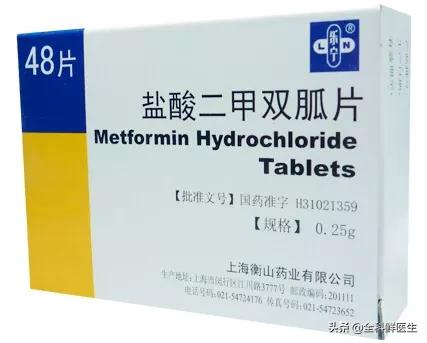
Metformin belongs to the class of biguanide hypoglycemic drugs, and its principle of hypoglycemia is to reduce blood glucose by decreasing the output of hepatic glucose and improving peripheral insulin resistance, increasing insulin sensitivity and lowering blood glucose. Diabetes treatment guidelines in many countries recommend metformin as the drug of choice for glycemic control, and the hypoglycemic effect of metformin has been found to be large in clinical trials resulting in a reduction of glycated hemoglobin by about 1% to 1.5%. In practice, metformin has been found to reduce glycated hemoglobin by about 0.7% to 1%, where the glucose-lowering effect gradually increases with increasing dose within a certain dosage range.
Acarbose is a glycosidase inhibitor, which reduces postprandial blood glucose by inhibiting the absorption of carbohydrates in the upper part of the small intestine, and it is mainly suitable for diabetic patients who eat rice and noodles as their staple food, and who also have predominantly elevated postprandial blood glucose. It has been found that the glucose-lowering effect of 300 mg of acarbose per day is comparable to that of 1,500 mg of metformin per day in patients with diabetes who are first diagnosed with the disease.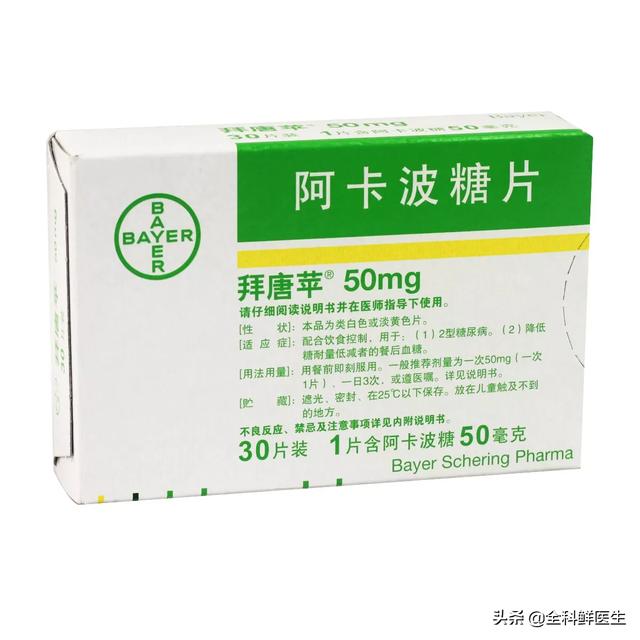
Although studies have concluded that the glucose-lowering effects of 300 mg of acarbose are essentially equivalent to those of 1,500 mg of metformin, the two drugs are also used clinically in combination to increase the glucose-lowering efficacy of the drugs while reducing the incidence of side effects.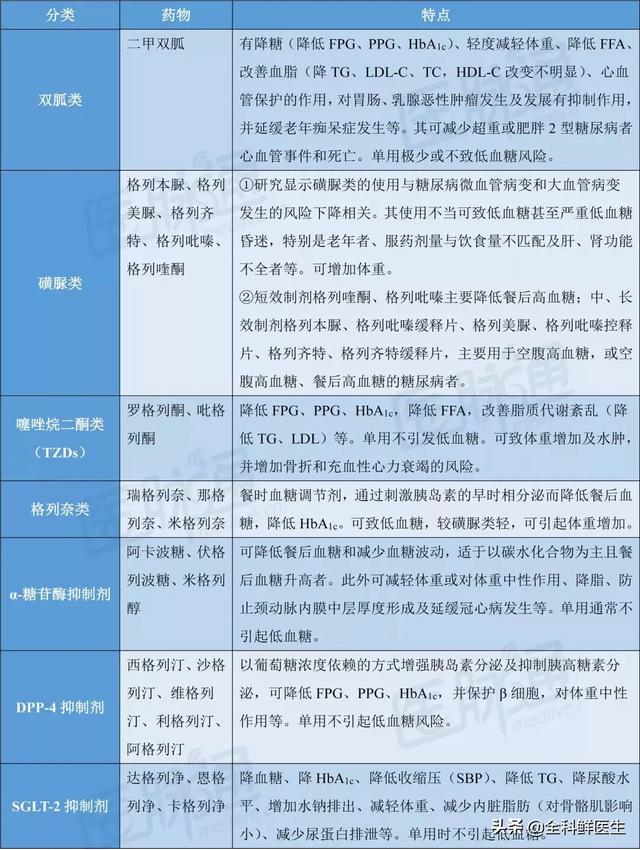
I am Dr. Fresh in General Practice, thank you for reading, thank you and good luck!
Metformin and acarbose are both commonly used glucose-lowering medications for diabetics. So, which one can lower blood sugar faster? In fact, there is no good or bad drug, but there is a difference between "suitable" and "unsuitable". These two drugs have different mechanisms for lowering blood sugar, it is difficult to say which one is faster, patients should choose different drugs according to their own blood sugar situation.
We will talk to you about metformin vs acarbose in detail, so I'm sure you'll have a good idea after reading this.
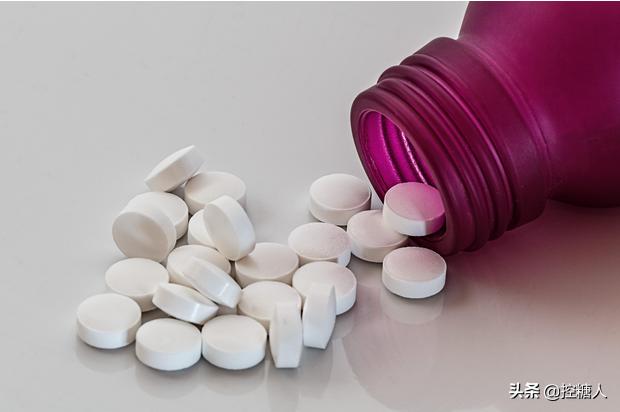
metformin
Most people with diabetes are familiar with metformin, which, is a very classic and effective drug for the treatment of type 2 diabetes, and the first-line drug for the treatment of type 2 diabetes internationally.Even some people with type 1 diabetes can take metformin in some cases.
Metformin effects
Metformin, mainly can inhibit the output of liver glycogen, at the same time increase the utilization of glucose in peripheral tissues and the sensitivity to insulin, so as to achieve the purpose of controlling blood sugar. It is not dependent on islet cell function, so it can be used for both type 2 and type 1 diabetes.
Primary Population
Metformin is suitable for patients with type 2 diabetes who cannot control their blood sugar well through diet or exercise regimen, and also for patients with pre-diabetes, polycystic ovary syndrome, and so on.It is particularly suitable for type 2 diabetes in weight obesity.
Metformin can be used in combination with other oral antidiabetic medications or with insulin to reduce fluctuations in blood glucose in patients with type 1 diabetes.
Dosage
According to diabetes treatment guidelines, the regular dose of metformin can be 1g twice/day.
However, the exact dosage needs to be determined by the doctor based on the patient's blood sugar, age, weight and other specifics.
Common side effects
- Gastrointestinal symptoms, manifested as dry mouth, bitter mouth, metal stomach, anorexia, nausea, vomiting, diarrhea, it is recommended to start with a small dose, slowly increase the dose of the drug, and the discomfort can often be relieved by itself after stopping the drug.
- Occasionally, allergic reactions have been observed, manifesting as skin erythema and hives.
- Long-term use of metformin can also lead to impaired absorption of vitamin B12 in patients, but it rarely triggers anemia.
- A serious adverse effect is the tendency to induce lactic acidosis, especially in states of hepatic and renal impairment, cardiac insufficiency, and hypoxia.Metformin itself does not harm the liver or kidneys, but poor kidney function can affect the excretion of the drug or can lead to problems such as accumulation of the drug or lactic acidosis, so it is not very suitable for renal insufficiency.
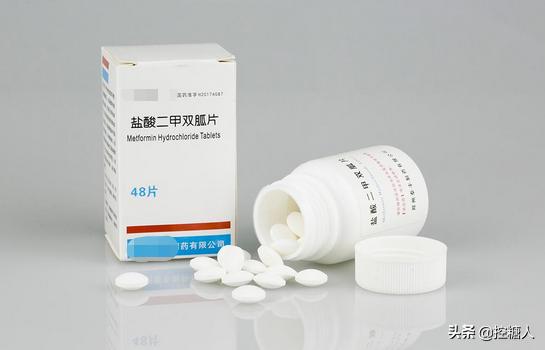
acarbose (loanword)
Acarbose Action
Acarbose tablets, also a first-line drug for diabetes treatment. Mainly through the inhibition of small intestinal wall cells and oligosaccharide competition, inhibit the activity of the enzyme, thus delaying the degradation of carbohydrates, so that the intestinal tract to delay the absorption of glucose, to reduce the postprandial postprandial glucose elevation.
In layman's terms, this means that acarbose inhibits or delays the absorption of carbohydrates, theAnd the level of a person's postprandial blood glucose depends mainly on the amount of carbohydrates he or she consumes, that is, the amount of rice, steamed bread and other staple foods. So Acarbose is mainly focused on lowering postprandial blood sugar.
Primary Population
Acarbose tablets are mainly used in type 2 diabetes mellitus with elevated postprandial blood glucose.
Dosage
The tablets can be swallowed right before a meal or chewed with the first few bites of food, usually 1 tablet 3 times a day. The exact dosage should also follow the doctor's instructions.
It is often combined with metformin, insulin, and sulfonylurea hypoglycemic agents.It is generally recommended to start with a small dose to reduce intestinal side effects.
Common side effects
The main side effects are flatulence, increased gas, elevated liver enzymes, bowel sounds, and rash or hives.
It is important to note thatIf, after taking acarbose, a patient develops hypoglycemia, it cannot be corrected by eating carbohydrates, but rather by drinking a sweetened beverage or taking glucose directly by mouth.
In summary, acarbose and metformin are mainly different mechanisms of action of lowering sugar, so it is also difficult to say which one is faster in lowering sugar, patients need to choose according to the physical condition and blood glucose, and then specifically to compare the following.

Acarbose vs Metformin
1. Mechanism of action
- Metformin: lowers blood glucose primarily by increasing insulin sensitivity and improving glucose utilization by peripheral tissues.
- Acarbose: lowers postprandial blood glucose by delaying the absorption of glycoconjugates.
2. Suitable for the crowd
- Metformin: suitable for diabetes with obesity. Metformin is recommended for patients with elevated fasting blood glucose or elevated fasting and postprandial blood glucose at the same time; young adults with good liver and kidney function and high BMI.
- Acarbose: Suitable for patients with high postprandial blood glucose. If simple postprandial blood glucose is elevated; acarbose is recommended for people who eat mainly starchy foods.
Conclusion:
Metformin and acarbose, both widely used in the clinic of glucose-lowering drugs, both belong to the first-line drugs, the two can be used in combination, and there is no good or bad, and there is no difference between the speed of glucose-lowering fast and slow.
Because the mechanism of action of these two drugs is different, it is recommended that diabetic patients choose the appropriate drug according to their own situation and under the guidance of their doctors.
I'm Sugar Control Man, I'm happy to popularize health knowledge for you ~ if you like my article, please click the upper right corner to follow me. If you have questions, you can leave a message in the comment section. Finally, thank you for reading and I wish you happiness and well-being!
Metformin and acarbose are both widely used oral hypoglycemic drugs, their hypoglycemic mechanism is different, so they can be used in combination, as for its side effects as well as the rate of hypoglycemia varies from person to person, with individual differences, dosage of medication, etc. are related.
First of all, let's talk about the drug metformin, this drug has been on the market for more than 50 years, and has been used in China for more than 20 years, it can be called the classic oral hypoglycemic drug, and with the study of the drug found that in addition to its hypoglycemic effect, it also has other pharmacological effects, such as cardiovascular protection, improve metabolism, improve the level of estradiol in female patients, improve menstrual disorders, induce ovulation, and it may be effective for some cancers, and also may also be effective against some cancers, and may slow down aging.
Metformin can be used in glucose lowering for patients over 10 years of age, for fasting blood glucose as well as postprandial blood glucose have good control, for the use of metformin alone, the role of the effect is not good, the metformin can be used as a basic hypoglycemic drugs, combined with other types of hypoglycemic drugs.
The starting dose of metformin is 500mg/d, and the optimal effective dose is 2g/d, so a gradual increase in dosage, as tolerated by the patient, can achieve significant long-term control. Monotherapy can result in a decrease in HbA1c of up to 1%-2%.
Metformin itself is not hepatorenal toxic, but if liver or kidney function is impaired, the dosage may need to be reduced to avoid accumulation of the drug in the body.

Acarbose its trade name is also known as Bay Sugar Apples, its main use in patients with high blood sugar after meals. Because of his mechanism of action, is by inhibiting the conversion of sugar in food into monosaccharides to be absorbed, so it can slow down the rapid rise in blood sugar after taking fifteen.
The use of acarbose is more effective for diabetics who normally consume more starch in their diet, such as those who eat more pasta and rice. It is generally recommended to take acarbose to be swallowed with the first mouthful of rice during a meal, or immediately after a meal to be able to maximize the effects of the drug.
The main adverse effect of acarbose may be gastrointestinal discomfort, as it prevents some starchy foods from being digested and absorbed in the intestines, leading to bloating, abdominal pain, and increased gas production. Symptoms may be more pronounced at the beginning of the use of the drug, and as time goes on, these symptoms may be milder and can be tolerated by most patients.
I'm Pharmacist Anonymous, click to follow and I'll share more of my drug knowledge with you.
Metformin and acarbose can be used in combination, they have different mechanisms of action, the effect of lowering sugar is affected by the patient's personal conditions, the rate of lowering sugar is not comparable. In terms of usage, metformin has a wider scope of application than acarbose.
I. Metformin
The glucose-lowering mechanism of metformin is to increase glycolysis in anaerobic state, inhibit intestinal absorption of grapes, increase peripheral utilization of glucose, decrease hepatic glucose output, and improve the body's sensitivity to insulin. It is effective in patients with both type 1 and type 2 diabetes mellitus, leads to weight loss, and does not cause hypoglycemia when used alone. The main adverse reactions are gastrointestinal reactions such as diarrhea, abdominal pain, and abdominal discomfort. A few patients may develop ketonuria or lactic acidemia.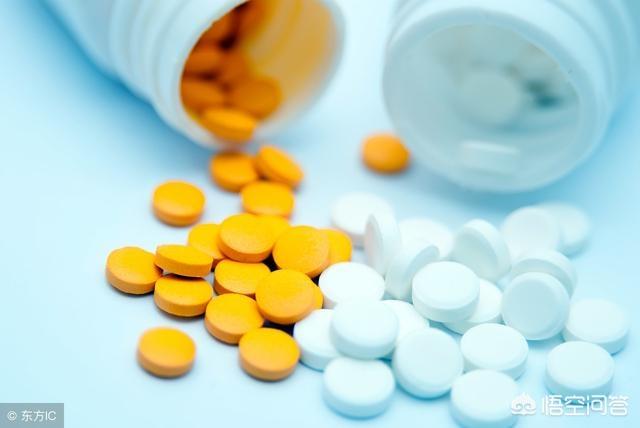
II. Acarbose
Acarbose needs to be taken with food, mainly in the intestine to inhibit the decomposition of polysaccharides in food into monosaccharides to be absorbed by the body. The hypoglycemic effect is related to the patient's dietary habits. If the patient mainly eats meat and less starchy food, the hypoglycemic effect of Acarbose will be very poor. Chinese people mostly take rice and noodles as their main food, so the hypoglycemic effect of Acarbose on Chinese diabetic patients is OK. Because it will make the carbohydrate food stay in the intestines without being absorbed, the main adverse effects will lead to gastrointestinal reactions such as abdominal bloating, increased gas, abdominal pain, and so on.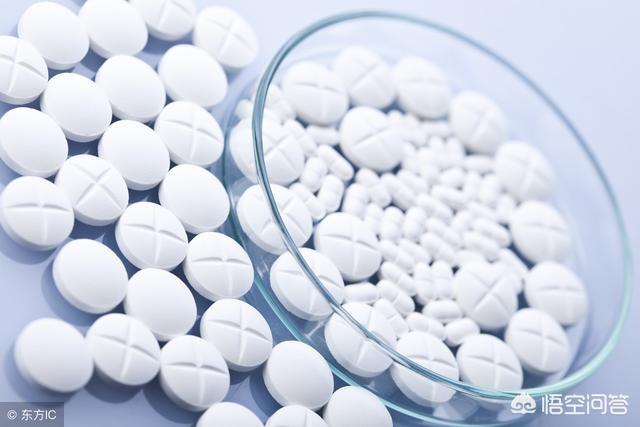
III. Comparison of the two, each has its own advantages
Metformin is more effective in controlling fasting blood sugarbut (not)Acarbose, on the other hand, has better postprandial glycemic control.. Diabetic patients can choose to use or combine with other hypoglycemic drugs according to the characteristics of their blood sugar high and low.
IV. Adverse reactions
The common adverse effect of both is gastrointestinal reaction, so when used in combination, gastrointestinal reaction may be aggravated, which can be relieved by eating more vegetables and less starchy food. Both require monitoring of liver and kidney function during administration. Acarbose needs to be taken with the first bite of food for maximum effect, and metformin is taken with food during a meal to reduce adverse effects. In other words, take acarbose first, followed by metformin, over the course of a meal. Also note that neither medication should be taken with alcohol while taking the medication.
Consult your doctor or pharmacist if you have any problems with the medication.I am Pharmacist Wazi, welcome to follow me and let me be the pharmacist by your side!
This question and answer are from the site users, does not represent the position of the site, such as infringement, please contact the administrator to delete.